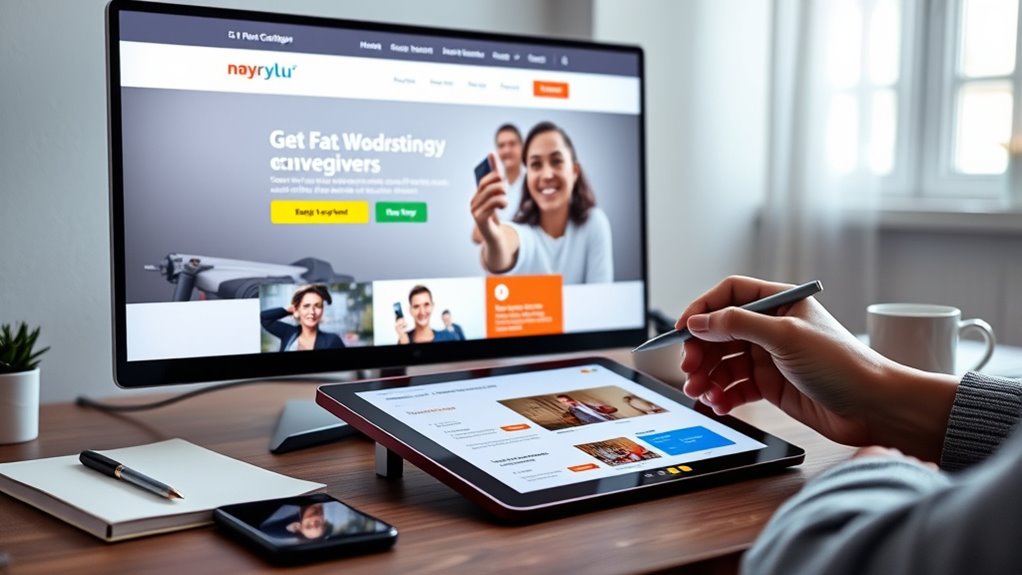To create landing pages that convert paid clicks successfully, focus on clear, benefit-driven headlines and compelling visuals that grab attention instantly. Make your CTAs stand out with contrasting colors and clear action words, placing them above the fold. Build trust through testimonials, reviews, and security badges, while highlighting benefits over features. Guarantee your page loads quickly and is mobile-friendly for a seamless experience. Keep these strategies in mind, and you’ll discover how to turn traffic into results.
Key Takeaways
- Craft compelling, benefit-driven headlines aligned with ad messaging to immediately capture attention.
- Design clear, prominent CTAs placed above the fold to drive immediate action.
- Use trust signals like testimonials and badges to boost credibility and reduce visitor hesitation.
- Optimize page speed and ensure mobile responsiveness for seamless user experience across devices.
- Focus on benefits over features with concise copy and engaging visuals to motivate conversions.

Creating a high-converting landing page is vital if you want your paid clicks to translate into real results. When visitors arrive on your page, they’re looking for a clear reason to take action—whether that’s making a purchase, signing up, or requesting more information. Your goal is to guide them smoothly toward that step without confusion or distraction. To do this, you need a focused, user-centric design that emphasizes clarity and persuasion. Keep your message straightforward and aligned with the ad that brought visitors there; inconsistency can cause them to bounce immediately.
Start with a compelling headline that immediately communicates the value you offer. It should be concise, benefit-driven, and attention-grabbing. Your visitors need to understand instantly what’s in it for them. Follow up with a subheadline or supporting statement that reinforces the main message. Use visuals sparingly but effectively—images or videos should support your copy and help illustrate your offer, not overwhelm or distract. People process visual information faster than text, so choose images that evoke emotion or demonstrate your product in action.
Start with a clear, benefit-driven headline and supporting visuals to instantly engage your audience.
The core of your landing page is your call-to-action (CTA). Make it prominent, action-oriented, and easy to find. Use contrasting colors, clear language, and strategic placement—often above the fold—so visitors see it without scrolling. Be specific about what you want them to do, whether it’s “Download Now,” “Get Your Free Trial,” or “Schedule a Demo.” Avoid vague or generic CTAs like “Click Here” or “Submit.” Instead, tell them exactly what they’ll get and why they should act now.
Trust is vital in converting paid traffic. Incorporate trust signals such as testimonials, reviews, security badges, or case studies to reassure visitors that your offer is credible. Keep your copy concise, focusing on benefits rather than features. Highlight how your product or service solves their problem, alleviates pain, or improves their situation. Use bullet points or short paragraphs to make information digestible and scannable.
Finally, optimize your landing page for speed and mobile devices. Slow-loading pages lead to high bounce rates, and many visitors will access your site via smartphones. Ensure buttons are large enough to tap easily, and that your layout adapts seamlessly across different screen sizes. Regularly test your landing page’s performance, tweak your messaging, and remove any elements that don’t contribute to conversions. By focusing on clarity, relevance, and user experience, you’ll create landing pages that turn paid clicks into loyal customers with remarkable efficiency.
Additionally, understanding your cookie categories and managing user consent appropriately can help improve user trust and compliance, which indirectly supports higher conversion rates.
Frequently Asked Questions
How Do I Test Different Landing Page Designs Effectively?
You should run A/B tests, changing one element at a time to see what impacts conversions. Use tools like Google Optimize or Optimizely to track performance accurately. Focus on key elements like headlines, images, and call-to-action buttons. Collect data over a sufficient period, then analyze results to identify what works best. Continuously test and refine your design to maximize your paid clicks’ effectiveness and conversion rates.
What Metrics Best Indicate a High-Converting Landing Page?
You should focus on metrics like conversion rate, which shows how many visitors take your desired action. Track bounce rate to see if visitors stay engaged, and monitor average session duration for insight into engagement level. Pay attention to click-through rates on calls-to-action, and analyze form completion rates. These metrics reveal how well your landing page persuades visitors to convert, helping you optimize for better results.
How Can I Optimize Landing Pages for Mobile Users?
You can make your landing pages more mobile-friendly by keeping design simple, ensuring fast load times, and optimizing buttons for touch. Use large, clear fonts and concise headlines to catch attention quickly. Test your pages on different devices regularly, and consider mobile-specific features like click-to-call. By focusing on these tweaks, you’ll provide a smooth experience that encourages visitors to engage and convert, no matter how they browse.
What Common Mistakes Reduce Landing Page Conversion Rates?
You often lose conversions by cluttering your landing page with too much text or distracting visuals. Ignoring mobile optimization, slow loading times, and unclear calls-to-action also hurt your chances. Don’t forget to neglect audience targeting or fail to test different layouts. By fixing these common mistakes, you’ll create a cleaner, more focused experience that guides visitors smoothly toward taking the desired action.
How Do I Personalize Landing Pages for Different Audience Segments?
Your landing pages can skyrocket conversions by personalizing for each audience segment. Use data like demographics, behavior, and preferences to tailor headlines, images, and offers. Dynamic content tools let you automatically adjust messaging based on visitor info, making each visitor feel like the page was built just for them. This targeted approach creates a more engaging experience, boosting trust and encouraging action—turning casual visitors into loyal customers.
Conclusion
By implementing these proven strategies, your landing pages will turn paid clicks into loyal customers like a well-oiled machine. Remember, your page is the gateway—make it inviting, clear, and compelling. Think of it as a first impression that leaves an indelible mark. With consistent tweaks and a keen eye on what works, you’ll see conversions soar and your marketing efforts truly pay off. Keep refining, and watch your success story unfold.









